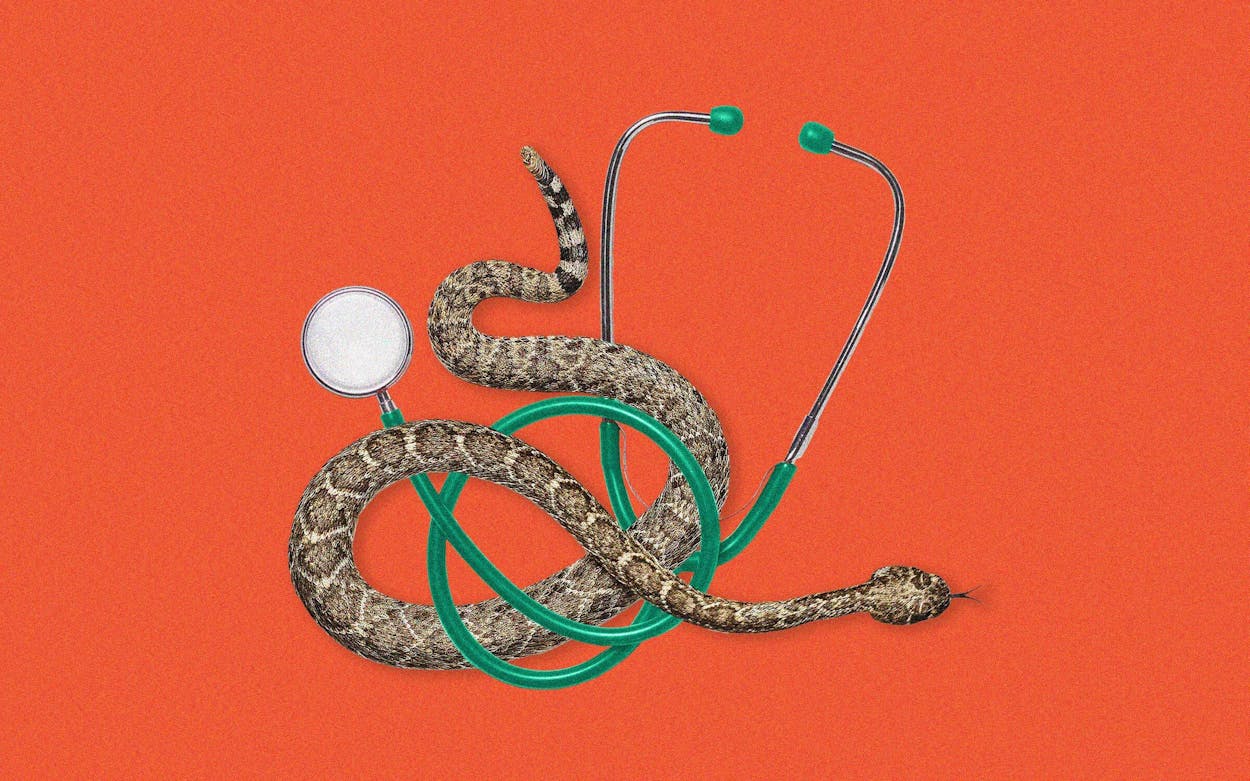Here is some good advice for you: there is no need, ever, to bring a snake to the emergency room.
This has always been true, but it came to broader public awareness recently, after a New York City doctor named Josh Trebach tweeted this guidance. His exasperated tone suggested that perhaps he had recently encountered a snakebite victim who felt the need to bring the snake to the ER with them.
In response, another Twitter user shared a photo from a Houston-area emergency room that fully and clearly indicated the facility’s snake process.
The five-step plan tasks the charge nurse with placing a dead or live snake that arrives in the ER into the “snake bucket.” The same (surely overworked and underpaid) nurse is then responsible for calling a business named Texas Snakes & More, which sends someone to retrieve the bucket and replace it with a fresh one for the next snake.
I called the number on the snake process document and shortly thereafter connected with Clint “the Snake Man” Pustejovsky, who has been in the snake retrieval business for years. He hadn’t seen the social media posts about the snake bucket, so I read him the ER protocol and asked if it sounded accurate. He was unfazed.
“That’s what I’ve been doing for years now,” he said. ER work isn’t the main thrust of his business—the Snake Man is a serpentine jack-of-all-trades who also does snake trapping, snake retrieval, snake education, children’s parties (!!!), and more—but, he says, hospital pickups are a fairly common part of the job. “It can be several times a month, or it can be slower. You know, I don’t think I’ve done one in many months now,” he told me.
Pustejovsky also reiterated Trebach’s guidance. “The truth is the snake does not need to be brought in there. Don’t do that. That’s always a problem,” he said—but while a layperson might be astonished that snakes are routinely brought into the emergency room, the herpetologist was not. “It doesn’t surprise me at all,” he told me. “I give talks all over the state, and I would say at least eighty percent of my audiences believe that you have to know the species of the snake [to be treated for a snakebite].”
The reason you don’t, according to Pustejovsky, is that only two antivenoms are approved in the U.S.—they’re known by the trade names Anavip and CroFab—and most hospitals will stock only one, either of which is broadly useful on almost any snakebite. (For deep antivenom-heads, the difference is that Anavip is horse-derived, while CroFab is sheep-derived.) Still, Pustejovsky doesn’t blame folks for laboring under the misconception that antivenom is species-dependent; most Texans, he says, don’t know a whole lot about snakes in the first place. In fact, according to Pustejovsky, half of the snakes he retrieves from emergency rooms aren’t even venomous.
“They’re paying me to remove a venomous snake, but they don’t know, and by the time I get there, by their regulations, I’m not supposed to open [the snake bucket] up there in the emergency room. Which makes sense,” he added. “I’m not going to break the regulations, but by the time I get outside, my curiosity is usually up at that point, so I’ll open it and then go, ‘Oh, shoot, it’s just a rat snake, doggone it.’ ”
Rat snakes aren’t venomous, but they will bite when threatened, which terrifies those of us who aren’t snake experts, because we aren’t trained to identify a cottonmouth or a rattler—all we know is “snakebite = dangerous.” Pustejovsky explained that rat snakes are really no different from any other wild animal when it comes to biting. “A guy that used to work for me, he came to pick up the snakes to do a snake show once, and he had scratches all over his leg. I asked him about it and he says, ‘You won’t believe it, but I’ll tell you, I got attacked by a squirrel!’ Which just goes to prove that it doesn’t matter what it is, it can attack you, I guess.”
Even in incidents when the snake is venomous, though, Pustejovsky said that there’s often good news—about half of those bites are what he calls “drive-by,” meaning that no venom exits the fangs.
Given that there are roughly seven to eight thousand venomous snakebites annually, these are useful facts to know—but regardless of which snake bites you, you can feel free to leave it where it is, as the ER doctors absolutely, positively do not need you to bring it in in order to treat you. In fact, the Snake Man believes that we’d all be better off if humans spent less time freaking out about snakes, period.
“The first thing I say in my presentations is, ‘The only good snake is a live snake,’ ” he said said, citing not just the commonly understood benefits of snakes, such as their consumption of rodents, but also more-obscure ones—say, the use of copperhead venom to inhibit cancer growth. “There’s so much that these animals have done for us.” So, in the event you find yourself bitten by one, spare it the indignity of ending its days in a bucket in the ER, and just take yourself to get treated quickly.








